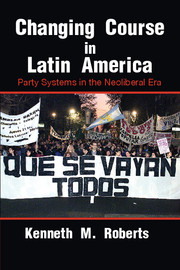Book contents
- Frontmatter
- Dedication
- Epigraph
- Contents
- List of Figures
- List of Tables
- Preface and Acknowledgments
- List of Abbreviations
- 1 Introduction: Party System Change in the Neoliberal Era
- Part I Explaining Regional Patterns
- Part II National Experiencesin Comparative Perspective
- 7 Critical Junctures in Elitist Party Systems
- 8 Critical Junctures in Labor-Mobilizing Party Systems
- 9 Aftermath: Reactive Sequences and Institutional Legacies
- 10 Conclusion: Political Legacies and the Crisis of Representation
- Appendix Election Results in Latin America
- References
- Index
10 - Conclusion: Political Legacies and the Crisis of Representation
Published online by Cambridge University Press: 18 December 2014
- Frontmatter
- Dedication
- Epigraph
- Contents
- List of Figures
- List of Tables
- Preface and Acknowledgments
- List of Abbreviations
- 1 Introduction: Party System Change in the Neoliberal Era
- Part I Explaining Regional Patterns
- Part II National Experiencesin Comparative Perspective
- 7 Critical Junctures in Elitist Party Systems
- 8 Critical Junctures in Labor-Mobilizing Party Systems
- 9 Aftermath: Reactive Sequences and Institutional Legacies
- 10 Conclusion: Political Legacies and the Crisis of Representation
- Appendix Election Results in Latin America
- References
- Index
Summary
Latin America’s crisis-induced transition from state-led development to market liberalism altered the social bases of political representation in fundamental ways. In so doing, it posed fundamental challenges to the ways in which parties had organized and represented popular interests and mediated between states and societies in the ISI era. In most countries, party systems at the beginning of the second decade of the 21st century looked strikingly different from those that were in place at the beginning of the democratic period in the early 1980s.
Party system change over the course of these three decades was indelibly marked by the dual transitions to democracy and market liberalism, but it was far from uniform in its character and effects. Although a handful of party systems were only lightly touched by the politics of crisis management and structural adjustment, most were realigned or partially reconstituted, and some broke down and decomposed along the way. Among the latter set of cases, the reconstruction of party systems proved to be a highly uncertain and asymmetrical process.
- Type
- Chapter
- Information
- Changing Course in Latin AmericaParty Systems in the Neoliberal Era, pp. 271 - 282Publisher: Cambridge University PressPrint publication year: 2015

